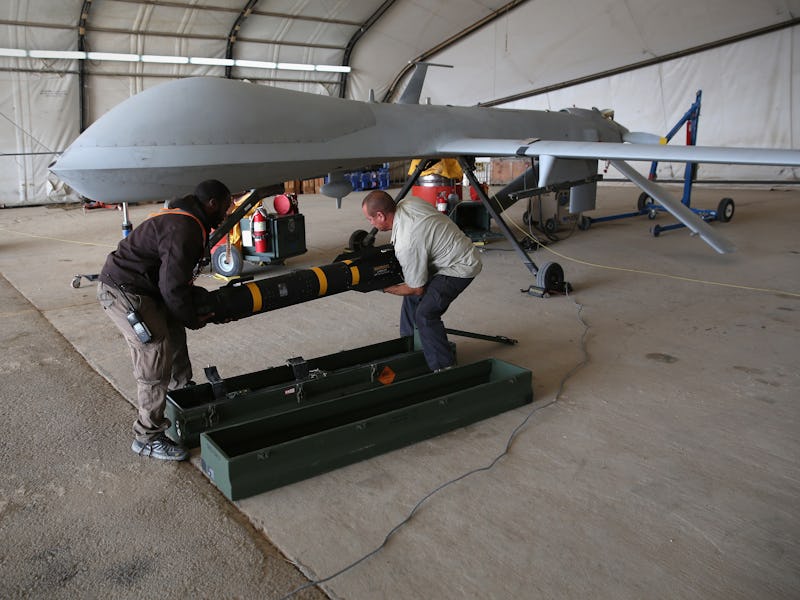Canada and Afghanistan Are Getting Military Drones, as the World's UAV Club Grows
Whether armed or merely for surveillance, the skies are only getting more crowded.

The list of countries who either have drones or want drones just got a little longer. The Afghan military is expected to begin flying unmanned vehicles for surveillance purposes later this month, with close assistance from NATO and international contractors. And although Canada recently announced its military would stop bombing ISIS targets, the Canucks are also quietly shopping around for drones which would likely be capable of firing lethal weapons.
To date four countries have used armed drones in combat, and an additional six countries have armed drones in their fleets, though they haven’t carried out lethal missions. That’s from data compiled by New America’s International Security Program, a think tank that researches drone proliferation. It cites a 2013 study from the Teal Group, a defense consulting firm, that estimates the global drone market will balloon from $6.8 billion to $11.4 billion annually. In all, New America says 86 countries “have some sort of drone capability, both armed and unarmed.” That number will continue to grow as the technology gets cheaper, and countries like China continue to sell armed drones to any country that is interested in buying.
Until recently, the United States maintained a virtual monopoly on lethal drone capability. The Obama administration runs semi-secret drone programs in Pakistan, Yemen, Somalia, and Syria, and in Afghanistan to assist the U.S. mission there. Critics of the Obama administration have argued that the lack of transparency and accountability in the drone programs could have the effect of weakening international norms against assassination and targeted killing. Now, as more and more countries and militant groups gain access to armed, remotely piloted vehicles, some human rights advocates worry that Obama’s precedent will give cover to other governments to create their own kill lists.
In Canada, Prime Minister Justin Trudeau’s decision to seek out drones with lethal capacity could prove to be a controversial decision. The Canadian Air Force has been pushing to acquire armed drones since at least 2011, but a lack of funding has hampered those efforts. Some international law experts see the U.S. program as an example of exactly what Canada should avoid. Errol Mendes told the National Post that any program “must be done with the utmost care and supervision.”
Two remotely piloted aircraft (RPA), an MQ-1B Predator (L) and an MQ-9 Reaper, are parked in a hanger at Creech Air Force Base on November 17, 2015 in Indian Springs, Nevada.
Afghanistan is about as different a country from Canada as you can find, but there, too, the government sees the benefits from unmanned vehicles, albeit for surveillance. President Ashraf Ghani is struggling to contain a resurgent Taliban that is as powerful as it’s been since the 2001 U.S. invasion. In addition, ISIS militants have found a foothold in the country, prompting the United States to increase airstrikes against the militants. Civilian deaths in Afghanistan hit a record high in 2015, and a small increase in surveillance and reconnaissance capabilities is unlikely to have a significant impact in the longest war in U.S. history.
The United States remains the country that has used the most lethal drone strikes by far. Now, as Donald Trump solidifies his grasp on the Republican nomination, the dangers of creating a secret killing program with secret kill lists are clearer than ever. Liberals long overlooked Obama’s preferred counter terrorism strategy of killing rather capturing suspected terrorists — despite his administration’s rhetoric to the contrary — so long as the president was a professorial executive they agreed with.
The idea of Donald Trump, however, sitting around on Terror Tuesdays and deciding who lives and who dies on the other side of the world is much more alarming. The same can be said for Ted Cruz, who has promised to “carpet bomb” Syria, and Marco Rubio, whose commitment to neoconservatism suggests he might start several new wars.
Globally, it’s clear that other countries are going to follow the States’ lead in establishing their own remote-controlled counter terrorism measures. Pakistan has already used drones to kill suspected militants in that country’s tribal areas. Drones aren’t necessarily evil, of course, and Pakistan’s traditional air force often destroys entire neighborhoods in their attempts to take out enemies. In some cases, the benefits that drones provide could help lessen civilian casualties. It’s worth noting, though, that for the U.S. military in Afghanistan, piloted missions resulted in far fewer civilian casualties than unmanned missions.
As Canada takes steps to join the armed drone club, there are signs from another western democracy about how Canada might deploy them. It’s unlikely Canada will set up massive programs like the U.S. has, but the Canadians might follow a model closer to the United Kingdom. In September, the UK killed two of its own citizens in a targeted drone strike in Syria. The two Britons had joined ISIS, but their apparent targeted assassination was controversial in the UK. “This was the deliberate killing of a British citizen. It is shocking. We have not seen this before,” Chris Cole, of the group Drone Wars, told The Guardian.
If U.S. policies post-9/11 have taught us anything, it’s that mission creep is common, and difficult to scale back once it gains momentum. As the list of countries who can kill remotely from afar grows, those lessons are more relevant than ever.